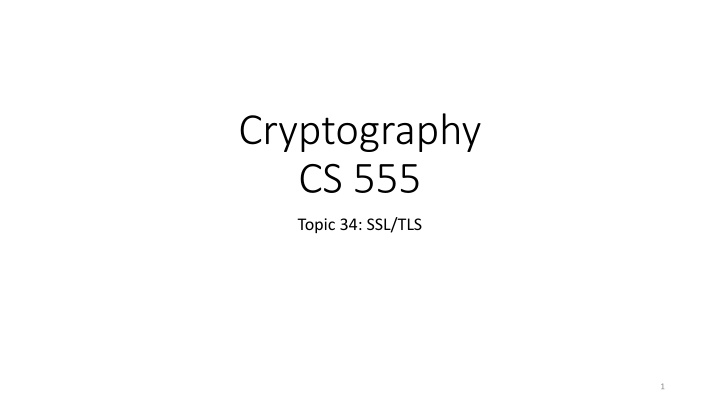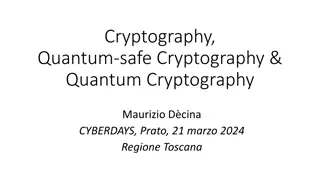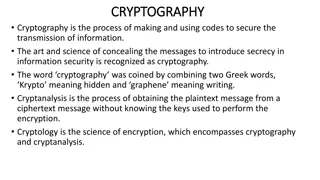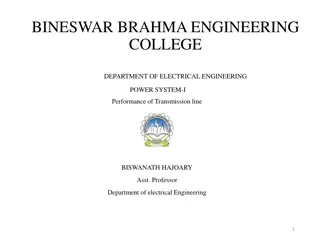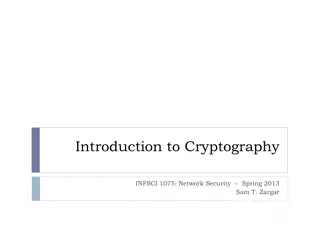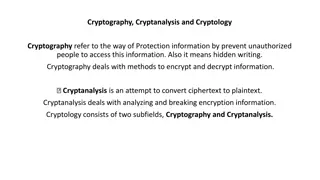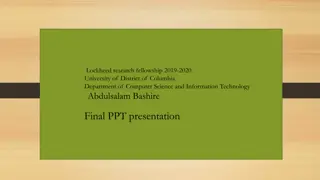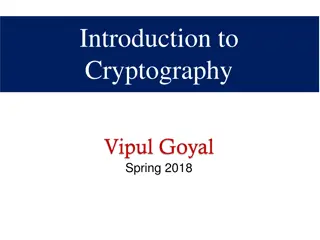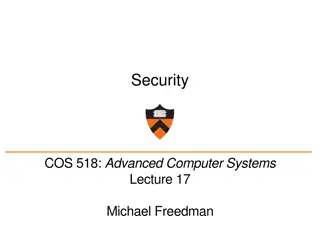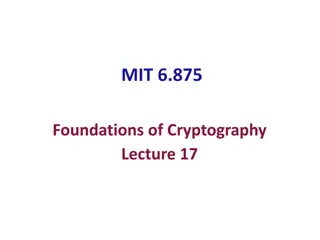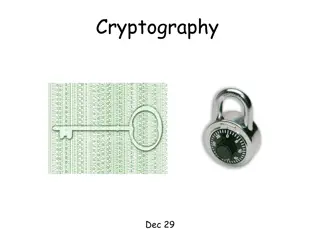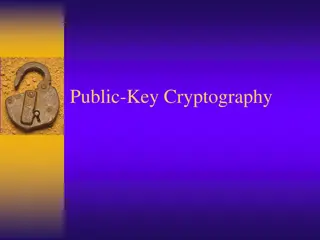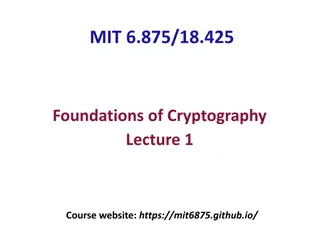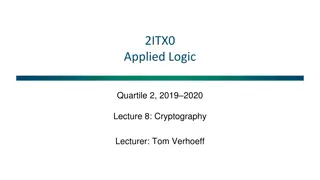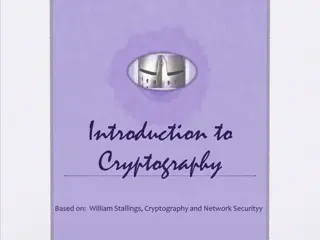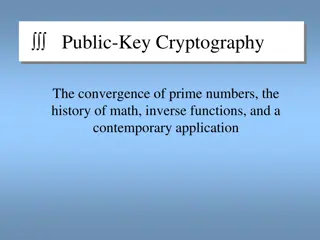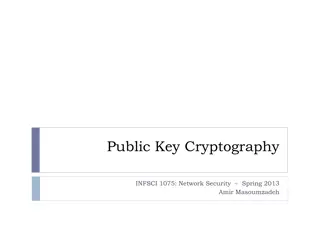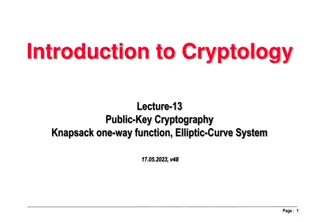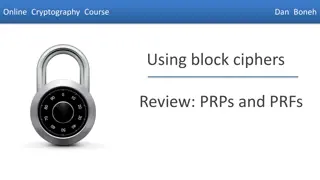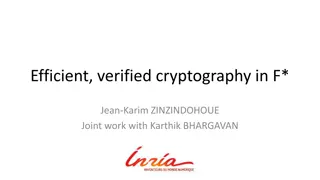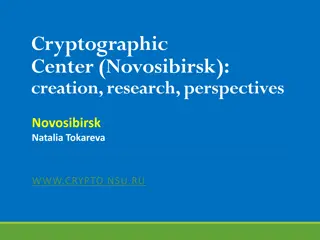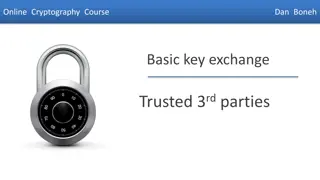Secure Information Transmission in Cryptography
Explore the concepts of secure information confidentiality, integrity, and authenticity in the realm of cryptography, including digital signatures, signcryption, and the challenges faced in ensuring secure communication. Delve into the attempts to encrypt, authenticate, and solve issues like non-repudiation in message transmission.
Download Presentation

Please find below an Image/Link to download the presentation.
The content on the website is provided AS IS for your information and personal use only. It may not be sold, licensed, or shared on other websites without obtaining consent from the author.If you encounter any issues during the download, it is possible that the publisher has removed the file from their server.
You are allowed to download the files provided on this website for personal or commercial use, subject to the condition that they are used lawfully. All files are the property of their respective owners.
The content on the website is provided AS IS for your information and personal use only. It may not be sold, licensed, or shared on other websites without obtaining consent from the author.
E N D
Presentation Transcript
Cryptography CS 555 Topic 34: SSL/TLS 1
Recap Digital Signatures Attacks on Plain RSA Signatures RSA-FDH Secure Identification Scheme + Fiat Shamir Transform Digital Signature Standard 2
What Does It Mean to Secure Information Confidentiality (Security/Privacy) Only intended recipient can see the communication Integrity (Authenticity) The message was actually sent by the alleged sender We need to break up -Bob I love you Alice - Bob Alice Bob 3
Signcryption: Authenticity + Confidentiality Public Key: pk=(vk,ek) vk is used to verify messages ek is used to encrypt messages Secret Key: sk=(dk,sk) dk is used to decrypt messages sk is used to sign messages Goal: Design a mechanism that allows a sender S to send a message m to a receiver R Integrity Secrecy 4
Attempt 1: Encrypt then Authenticate Sender S computes c = Enc???? and sends R ?,?,Sign???? Receiver R decrypts c and then validates the signature This is the approach we used to build Authenticated Encryption with MACs Any problems here? 5
Attempt 1: Encrypt then Authenticate Devil,?,Sign???????? ???,?,Sign???? I wrote you this poem I wrote you this poem Alice Bob 6
Attempt 1: Encrypt then Authenticate Sender S computes c = Enc???? and sends R ?,?,Sign???? Receiver R decrypts c and then validates the signature This is the approach we used to build Authenticated Encryption with MACs Another Issue: How can R convince judge that sender S signed the message m? Judge can verify that S signed the ciphertext, but needs R s key to decrypt c. 7
Attempt 2: Authenticate then Encrypt Sender S computes = Sign???? and sends R ?,Enc???? Receiver R decrypts ciphertext to obtain m and then validates the signature Solve the issue of non-repudiation. Receiver obtains a signature for m Any other Issues? 8
Attempt 2: Authenticate then Encrypt You are despicable Alice ???,Enc???????? You are despicable Bob 9
Attempt 3: Sender S computes = Sign???? ? and sends R ?,Enc???? ? This works So does encrypt then authenticate with c = Enc???? ? ?,?,Sign???? ? Rule of Thumb: When signing a message with your secret key include identity of receiver When encrypting message with someone s public key include your identity in message 10
Transport Security Layer (TLS) Standardized protocol based on processor SSL (Secure Socket Layer) Used for https connections by your browser Multiple Versions TLS 1.0, 1.1, 1.2 (version 1.3 in progress https://tools.ietf.org/html/draft-ietf-tls-tls13-18 ) We will focus only on high level details 11
Transport Security Layer (TLS) First Goal: Agree on a set of keys For Confidentiality Also Authentication Handshake Precondition: Client has a subset of {pk1, pkn} --- public keys for several Certificate Authorities Server has a key-pair (pks,sks) for a KEM 1. Client C begins by sending S a message indicating 1. Protocol Versions + Ciphertext suites that he can run 2. A random nonce NC 12
Transport Security Layer (TLS) 1. Client C begins by sending S a message indicating 1. Protocol Versions + Ciphertext suites that he can run 2. A random nonce NC 2. S responds by selecting the most recent version of the protocol it supports as well as an appropriate ciphersuite 1. Also sends pkS and certificate ????? ? (signed message form certificate authority i validating pkS) 2. A nonce NS 3. C checks to see if it has pki for CAi. 1. Yes? Verify the certificate and ensure that it is not expired/revoked 2. No? Abort/Ask Again 13
Transport Security Layer (TLS) 1. Client C begins by sending S a message indicating 1. Protocol Versions + Ciphertext suites that he can run 2. A random nonce NC 2. S responds by selecting the most recent version of the protocol it supports as well as an appropriate ciphersuite 1. Also sends pkS and certificate ????? ? (signed message form certificate authority i validating pkS) 2. A nonce NS 3. C checks to see if it has pki for CAi. 1. Assuming pkSis validated 2. C runs ?,??? Encaps???1? (pmk is pre-master key) 3. C sends c to S (who will later use c and skS to recover pmk) 4. C computes mk=KDF(pmk,NC,NS) (mk is master key) 5. C computes four keys kC,kC ,kS,kS = PRG(mk) 6. C computes ?? MAC???????????? and sends ???????,MAC? ???????? to S 14
Transport Security Layer (TLS) Client Sends Message kC kC Sever Sends Message kS kS 1. Client C begins by sending S a message indicating 1. Protocol Versions + Ciphertext suites that he can run 2. A random nonce NC 2. S responds by selecting the most recent version of the protocol it supports as well as an appropriate ciphersuite 1. Also sends pkS and certificate ????? ? (signed message form certificate authority i validating pkS) 2. A nonce NS 3. C checks to see if it has pki for CAi. 1. Assuming pkSis validated 2. C runs ?,??? Encaps???1? (pmk is pre-master key) 3. C sends c to S who recovers pmk 4. C computes mk=KDF(pmk,NC,NS) (mk is master key) 5. C computes four keys kC,kC ,kS,kS = PRG(mk) 6. C computes ?? MAC???????????? and sends ???????,MAC? ???????? Encryption MAC to S 15
Transport Security Layer (TLS) 3. C checks to see if it has pki for CAi. 1. Assuming pkSis validated 2. C runs ?,??? Encaps???1? (pmk is pre-master key) 3. C sends c to S who recovers pmk 4. C computes mk=KDF(pmk,NC,NS) (mk is master key) 5. C computes four keys kC,kC ,kS,kS = PRG(mk) 6. C computes ?? MAC???????????? and sends ???????,MAC? ???????? Sever 1. Computes ??? Decaps???? 2. Computes mk=KDF(pmk,NC,NS) (mk is master key) 3. Computes four keys kC,kC ,kS,kS = PRG(mk) 4. Validates ???????,MAC? ???????? 1. Decrypt ??????? with to obtain ?? 2. If Vrfy? ????????,MAC? ???????? 3. Otherwise server and client agree so far on communication to S 4. by 1 or Vrfy????????????,?? 1 then abort 16
Transport Security Layer (TLS) 4. Sever 1. 2. 3. 4. Computes ??? Decaps???? Computes mk=KDF(pmk,NC,NS) (mk is master key) Computes four keys kC,kC ,kS,kS = PRG(mk) Validates ???????,MAC? ???????? 1. Decrypt ??????? with to obtain ?? 2. If Vrfy? ???,MAC? ???????? 3. Otherwise server and client agree so far on communication S computes ?? MAC???????????? and sends ???????,MAC? ???????? by 1 or Vrfy????????????,?? 1 then abort 5. to C 5. Client validates ??; otherwise aborts 17
Security Intuition C verifies certificate so it knows it is talking to S Knows that only legitimate S can learn pmk and mk If protocol finishes successfully then C knows that it shares four keys kC,kC ,kS,kS with S MAC on transcript? Ensures consistency Man-in-the-Middle attacker may attempt to modify ciphersuite E.g., force C and S to use old version of cipher with security bugs etc 18
Transport Security Layer (TLS) Record Layer Protocol once C and S share keys they start communication Client Sends Message kC kC Sever Sends Message kS kS Encryption MAC Sequence numbers prevent replay attacks TLS 1.2 used authenticate-then-encrypt (can be problematic) 19
Building Authenticated Encryption Attempt 3: (Authenticate-then-encrypt) Let Enc?? Secure encryption scheme and let Mac?? ? = ??,?? then ? be a CPA- ? be a secure MAC. Let ????? = Enc?? ? ? , where t = Mac?? ? Can be problematic for some CPA-Secure schemes 20
Building Authenticated Encryption Attempt 3: (Authenticate-then-encrypt) Let Enc?? Secure encryption scheme and let Mac?? ? = ??,?? then ? be a CPA- ? be a secure MAC. Let ????? = Enc?? ? ? , where t = Mac?? ? ????? = 1. ? = Dec?? 2. Parse as ? ?. If Vrfy?? authentication failure ? . If ? is not padded correctly return bad padding ?,? = 1 return m. otherwise output 21
Building Authenticated Encryption ????? = 1. ? = Dec?? 2. Parse as ? ?. If Vrfy?? authentication failure ? . If is not padded correctly return bad padding ?,? = 1 return m. otherwise output It is hard to ensure that the error messages cannot be distinguished! Timing Attacks Debugging Generic Integration of MAC scheme with Encryption scheme? 22
Next Class: Multiparty Computation Finished with Katz and Lindell! Read Wikipedia entry on Secure Multi-party computation Read Katz and Lindell page 187-188 (commitment schemes) OK, almost done 23
